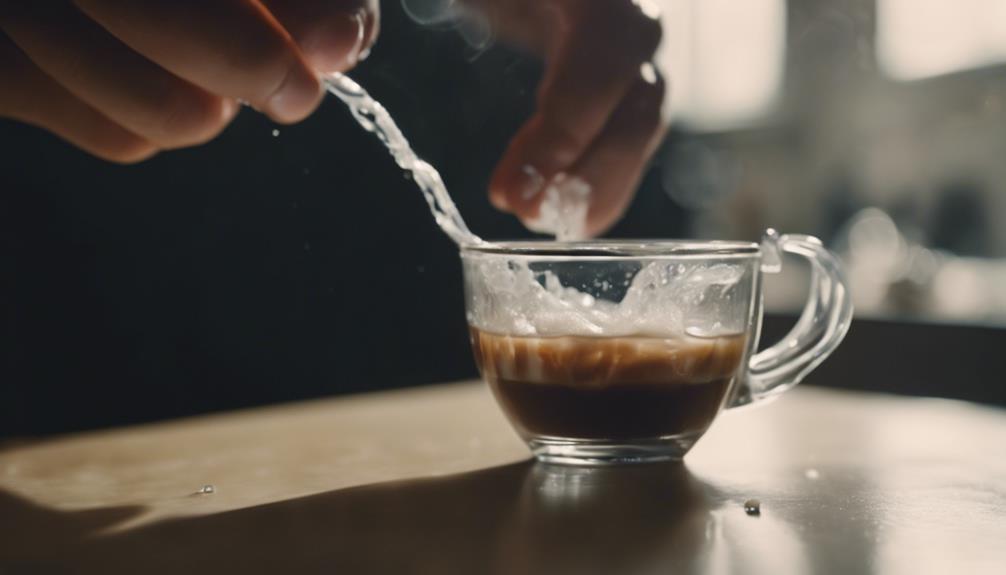You can safely drink coffee while wearing retainers, but it’s important to consider the type of retainer you have. Metal retainers are less likely to be stained by coffee because of their non-porous composition, making them a better option for coffee drinkers compared to acrylic or ceramic retainers. Plastic retainers can be warped by hot coffee due to sudden temperature changes. Choosing high-quality, low-acid coffee can help prevent staining on retainers. Knowing these factors can help preserve the appearance and durability of your retainers while still enjoying your favorite cup of coffee. Interested in learning more about effectively caring for your retainers?
Key Takeaways
- Metal retainers are safest for coffee drinkers due to their resistance to staining.
- Avoid wearing porous retainers like acrylic or ceramic while consuming coffee.
- High-quality, low-acid coffee options help prevent staining on retainers.
- Hot coffee can damage plastic retainers, so remove them before consuming.
- Regular cleaning and care for retainers can help minimize coffee-related issues.
Types of Retainers and Coffee Compatibility
Different types of retainers react differently when exposed to coffee, impacting their susceptibility to staining. Porous materials like acrylic and ceramic retainers are more prone to coffee stains compared to non-porous materials like metal retainers.
Ceramic retainers, due to their porous nature, are susceptible to staining from coffee. On the other hand, metal and wire retainers are less likely to stain from coffee due to their non-porous composition.
Understanding how these different types of retainers interact with coffee is essential in choosing the most suitable option for your oral care needs.
When considering wearing retainers while drinking coffee, it's important to note that metal retainers may be a more coffee-friendly option compared to porous materials like acrylic or ceramic.
Ceramic Vs. Plastic Retainers: Coffee Impact

When comparing ceramic and plastic retainers in relation to coffee impact, plastic retainers are less prone to staining than ceramic ones due to their non-porous composition.
Ceramic retainers, being porous, are more susceptible to coffee staining, which can lead to discoloration and affect their appearance over time.
On the other hand, plastic retainers are less likely to stain from coffee consumption, making them a more suitable choice for individuals who enjoy coffee regularly.
Opting for plastic retainers over ceramic ones can help minimize the impact of coffee staining, ensuring that your retainers maintain their appearance and functionality.
Understanding the material differences between ceramic and plastic retainers is crucial for managing the effects of coffee consumption while wearing retainers.
Wire Vs. Metal Retainers With Coffee

Metal retainers are known to be more resistant to coffee staining compared to wire retainers, making them a preferable option for individuals who enjoy coffee regularly.
When choosing between wire and metal retainers, consider the following:
- Visibility: Metal retainers are less likely to show coffee stains visibly compared to wire retainers.
- Resistance: Metal retainers offer better resistance to discoloration from coffee consumption.
- Maintenance: Wire retainers may require more frequent cleaning to prevent noticeable coffee stains.
- Longevity: Metal retainers tend to maintain their appearance better over time with coffee consumption.
- Impact: The choice between wire and metal retainers can have a significant effect on the visibility of coffee stains on your retainer.
Coffee Quality and Retainer Staining

Choosing high-quality, low-acid coffee options is key in preventing staining on your retainers. Dark pigmentation and acidity found in some coffees can gradually lead to discoloration on your retainers over time.
Understanding how different coffee qualities and roasts can impact staining will help you maintain the appearance of your retainers.
Stain Prevention Methods
To reduce staining on your retainers while enjoying your daily coffee, consider selecting high-quality, low-acid varieties that are less likely to cause discoloration.
Here are some stain prevention methods to help you maintain the appearance of your retainers:
- Opt for dark roast coffee varieties as they've fewer staining agents compared to lighter roasts.
- Understand how coffee acidity affects the potential for staining, and choose varieties with lower acidity levels.
- Explore non-staining beverage options such as tea or herbal infusions to minimize the risks of discoloration.
- Enjoy flavorful alternatives like hot chocolate, which can provide a tasty option without the staining effects of coffee.
- Rinse your mouth with water after consuming acidic beverages to help reduce the likelihood of staining on your retainers.
Retainer Cleaning Tips
Regularly cleaning your retainers after consuming coffee, especially if they're porous materials like acrylic or ceramic, is essential to prevent staining and maintain their appearance.
When dealing with Invisalign aligners or other porous retainers, proper care is vital in preventing coffee stains. To effectively clean your retainers post-coffee consumption, consider using retainer cleaning tablets. These tablets are specifically designed to eliminate stains and bacteria, helping to preserve the quality of your retainers.
Additionally, opting for high-quality, low-acid coffee options can reduce the staining effects on different types of retainers. Understanding how coffee acidity affects staining potential can aid in choosing the right retainer type and implementing suitable cleaning routines.
Temperature Effects on Retainers From Coffee

Hot coffee can have detrimental effects on plastic retainers, potentially warping or distorting their shape. When exposed to hot drinks like coffee, plastic retainers, such as Invisalign, are at risk of damage due to the sudden temperature changes.
Here are some key points to keep in mind regarding the temperature effects on retainers from coffee:
- Warped Shape: The heat from hot coffee can cause plastic retainers to warp, leading to an improper fit.
- Cracking and Deformation: Sudden temperature changes can result in acrylic retainers cracking or deforming.
- Material Softening: Prolonged exposure to hot coffee can soften the material of clear plastic retainers, compromising their structure.
- Metal Retainers: Metal and wire retainers are generally less affected by temperature changes from coffee compared to plastic ones.
- Preventive Measures: To avoid these issues, it's recommended to remove retainers before wearing them while consuming hot beverages like coffee.
Retainer Care Tips for Coffee Drinkers

Consider incorporating a designated cleaning routine to maintain the appearance and longevity of your retainers after enjoying your coffee. Coffee's dark pigmentation and acidity can lead to staining on retainers, affecting their appearance over time. To minimize staining effects and guarantee proper care for your retainers, follow these tailored tips for coffee drinkers:
| Care Tip | Description | Importance |
|---|---|---|
| Rinse After Coffee | Immediately rinse your retainers with water after consuming coffee to prevent stains from setting in. | High |
| Brush Gently | Use a soft-bristled toothbrush to gently clean your retainers with non-abrasive toothpaste to remove coffee residue. | Medium |
| Soak Regularly | Soak your retainers in a retainer cleaning solution at least once a week to maintain their cleanliness and freshness. | High |
Frequently Asked Questions
Can I Drink Coffee While Wearing My Retainer?
While wearing your retainer, it isn't advisable to drink coffee. Coffee's pigmentation and acidity can stain and weaken retainers over time. The high acidity in coffee may also contribute to enamel erosion and potential oral health issues if consumed while wearing retainers.
To prevent staining and maintain the appearance of your retainer, it's best to remove it before consuming coffee. Proper care post-coffee consumption is essential to preserve the integrity of your retainer.
Can I Wear My Retainer While Drinking?
While wearing retainers, it's advisable to avoid drinking beverages like coffee due to potential staining and enamel erosion risks. Safely drinking coffee with retainers involves removing them before consuming the beverage and then thoroughly brushing and cleaning both the retainers and teeth afterwards. It’s also recommended to use a straw when enjoying drinks like coffee or tea to minimize contact with the teeth and reduce the risk of staining. Additionally, regular visits to the dentist can help monitor any potential issues with enamel erosion and provide guidance on maintaining oral health while wearing retainers.
To maintain your retainers' integrity and prevent discoloration, it's best to remove them before consuming staining liquids.
Prioritize oral health by rinsing thoroughly after coffee intake and cleaning your retainers regularly.
Minimize the chances of damage by being cautious with beverages that can affect your oral appliances.
Will Coffee Stain the Retainer?
Coffee can stain retainers, particularly those made of porous materials like acrylic or ceramic. The dark pigmentation and acidity in coffee can lead to discoloration over time.
Opt for non-porous materials like metal or wire to minimize staining. Regular cleaning after consuming coffee can help prevent discoloration.
Choose your retainer wisely based on lifestyle to reduce the impact of coffee stains.
When Should You Not Wear Your Retainer?
You shouldn't wear your retainer when consuming beverages or foods that can stain or damage it, such as coffee, tea, or colored sodas. Removing your retainer before eating or drinking helps prevent discoloration, maintain its appearance, and avoid potential long-term damage.
It's advisable to clean your retainer thoroughly after every meal or snack to guarantee proper oral hygiene and preserve the integrity of the retainer.
Conclusion
To sum up, while it's generally safe to wear retainers while drinking coffee, the type of retainer you have can impact its compatibility with coffee. Ceramic retainers may be more susceptible to staining, while wire or metal retainers may be more resilient.
To maintain the quality and cleanliness of your retainers, it's important to follow proper care tips and be mindful of the temperature of the coffee you consume.
Stay informed and enjoy your coffee responsibly with your retainers.









